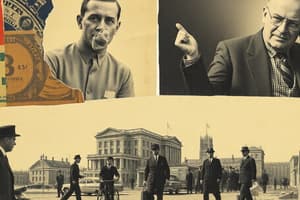Podcast
Questions and Answers
What was one significant economic factor that contributed to the Great Depression?
What was one significant economic factor that contributed to the Great Depression?
- High employment rates
- Government deregulation
- Increased consumer spending
- Over-speculation in the stock market (correct)
How did high tariffs like the Smoot-Hawley Tariff impact the economy during the Great Depression?
How did high tariffs like the Smoot-Hawley Tariff impact the economy during the Great Depression?
- They stifled international trade. (correct)
- They increased consumer confidence.
- They reduced government revenue.
- They stimulated international trade.
What was one of the notable responses to the Great Depression in the United States?
What was one of the notable responses to the Great Depression in the United States?
- Deregulation of the banking sector
- The New Deal programs (correct)
- Expansion of international trade agreements
- The establishment of the Federal Reserve
What was a major societal effect of the Great Depression?
What was a major societal effect of the Great Depression?
Which characteristic best describes the Great Depression?
Which characteristic best describes the Great Depression?
What role did bank failures play in the Great Depression?
What role did bank failures play in the Great Depression?
What was the ultimate factor that contributed to ending the Great Depression in the United States?
What was the ultimate factor that contributed to ending the Great Depression in the United States?
What economic condition exacerbated the Great Depression's effects?
What economic condition exacerbated the Great Depression's effects?
Flashcards
Stock Market Crash of 1929
Stock Market Crash of 1929
A major trigger of the Great Depression, characterized by a rapid and devastating decline in stock prices due to over-speculation and inflated prices.
Bank Failures
Bank Failures
Poorly managed banks heavily invested in the stock market, leading to public loss of confidence, massive savings withdrawals, and a major blow to the financial system.
High Tariffs (e.g., Smoot-Hawley)
High Tariffs (e.g., Smoot-Hawley)
Restrictions on international trade that worsened the Great Depression by hindering global economic recovery and causing widespread hardship.
Uneven Wealth Distribution
Uneven Wealth Distribution
Signup and view all the flashcards
Reduced Consumer Spending
Reduced Consumer Spending
Signup and view all the flashcards
Agricultural Issues
Agricultural Issues
Signup and view all the flashcards
Great Depression Unemployment
Great Depression Unemployment
Signup and view all the flashcards
New Deal
New Deal
Signup and view all the flashcards
Government Intervention
Government Intervention
Signup and view all the flashcards
Worldwide Phenomenon
Worldwide Phenomenon
Signup and view all the flashcards
Fragility of Global Capitalism
Fragility of Global Capitalism
Signup and view all the flashcards
Study Notes
Causes
- The stock market crash of 1929 is widely considered a trigger.
- Over-speculation and inflated stock prices in the 1920s led to a rapid and devastating decline.
- Bank failures played a crucial role; many banks were poorly managed and invested heavily in the stock market. This led to a loss of public confidence and a massive withdrawal of savings.
- High tariffs, such as the Smoot-Hawley Tariff, stifled international trade, worsening the economic downturn.
- Reduced consumer spending and investment fueled by fear and uncertainty played a significant role.
- Uneven distribution of wealth exacerbated the crisis; the rich held a disproportionate amount of the nation's wealth, resulting in lower consumer demand for goods.
- Agricultural issues, such as falling farm prices and overproduction, contributed to the widespread economic hardship.
Effects
- Widespread unemployment and poverty defined the era. Millions lost their jobs and homes.
- Reduced industrial output and agricultural production across the nation were significant.
- The banking system suffered significant damage, with countless banks collapsing.
- Societal hardship was profound, with increased homelessness, malnutrition, and psychological distress.
- Increased political activism and social unrest was a direct result of the crises.
- Governments worldwide struggled to manage the crises, leading to shifts in economic policy.
Responses
- The New Deal, a series of programs and projects implemented by President Franklin D. Roosevelt, was a major response.
- The New Deal aimed to provide relief, recovery, and reform.
- Government intervention in the economy expanded significantly as a result of these programs.
- The New Deal had mixed success; some programs achieved substantial outcomes, while others had limited effect.
- World War II ultimately ended the Great Depression in the United States, due in large part to increased production and demand related to wartime mobilization.
Key features and characteristics
- The Great Depression was a worldwide phenomenon that affected most developed nations.
- It was a severe and long-lasting economic downturn, lasting for approximately a decade.
- It displayed the fragility of global capitalism and the potential for severe economic instability.
- The Depression exposed weaknesses in existing economic systems and policies.
- The Depression significantly shaped modern financial regulations and economic policies focused on stabilization and preventing future crises.
Studying That Suits You
Use AI to generate personalized quizzes and flashcards to suit your learning preferences.




